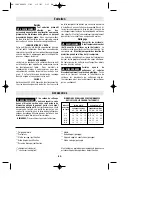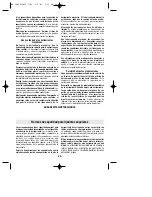
Grinding Operations
SANDING WOOD
When sanding wood the direction of the disc
motion at the contact point should parallel the
grain as much as possible. The rapid cut of
discs and the swirl type scratch pattern they
occasionally create generally prohibit their
use for producing the final finish.
Scratches and circular marks are usually the
result of using too coarse a grit. When
changing to a finer grit, move across the
sanding lines that were made by a previous
coarser disc.
SANDING METAL
When sanding automobiles or appliances,
wipe the metal clean with a non-flammable
solvent or commercial cleaner to remove all
wax and grease. By doing this first, the
sanding discs will sand better and last longer.
For heavy duty work, use a coarse grit disc
first. Follow-up with a medium grit to remove
scratches. To produce smooth finish, use fine
grit disc.
Wire Brush Operations
SELECTING GRINDING WHEELS
Before using a grinding wheel, be certain that
its maximum safe operating speed is not
exceeded by the nameplate speed of the
grinder. Do not exceed the recommended
wheel diameter.
DISC GRINDING WHEELS
Grinding wheels should be carefully selected
in order to use the grinder most efficiently.
Wheels vary in type of abrasive, bond,
hardness, grit size and structure. The correct
type of wheel to use is determined by the job.
Use disc grinding wheels for fast grinding of
structural steel, heavy weld beads, steel
casting, stainless steel and other ferrous
metals.
GRINDING TIPS
Efficient grinding is achieved by controlling
the pressure and keeping the angle between
wheel and workpiece at 10° to 15°. If the
wheel is flat, the tool is difficult to control. If
the angle is too steep, the pressure is
concentrated on a small area causing
burning to the work surface.
Excessive or sudden
pressure on the wheel will
slow grinding action and put dangerous
stresses on the wheel.
When grinding with a new wheel be certain to
grind while pulling tool backwards until wheel
becomes rounded on its edge. New wheels
have sharp corners which tend to “bite” or cut
into workpiece when pushing forward.
!
WARNING
-11-
Wire brushes are intended to “clean”
structural steel, castings, sheet metal, stone
and concrete. They are used to remove rust,
scale and paint.
Avoid bouncing and snag-
ging the wire brush, espe-
cially when working corners, sharp edges etc.
This can cause loss of control and kickback.
BRUSHING PRESSURE
1. Remember, the tips of a wire brush do the
work. Operate the brush with the lightest
pressure so only the tips of the wire come in
contact with the work.
2. If heavier pressures are used, the wires
will be overstressed, resulting in a wiping
action; and if this is continued, the life of the
brush will be shortened due to wire fatigue.
3. Apply the brush to the work in such a way
that as much of the brush face as possible is
in full contact with the work. Applying the side
or edge of the brush to the work will result in
wire breakage and shortened brush life.
!
WARNING
15
°
CORRECT:
Wire tips doing the work.
INCORRECT:
Excessive pressure can cause wire breakage.
BM 1609929H55 1-05 1/5/05 3:17 AM Page 11












































